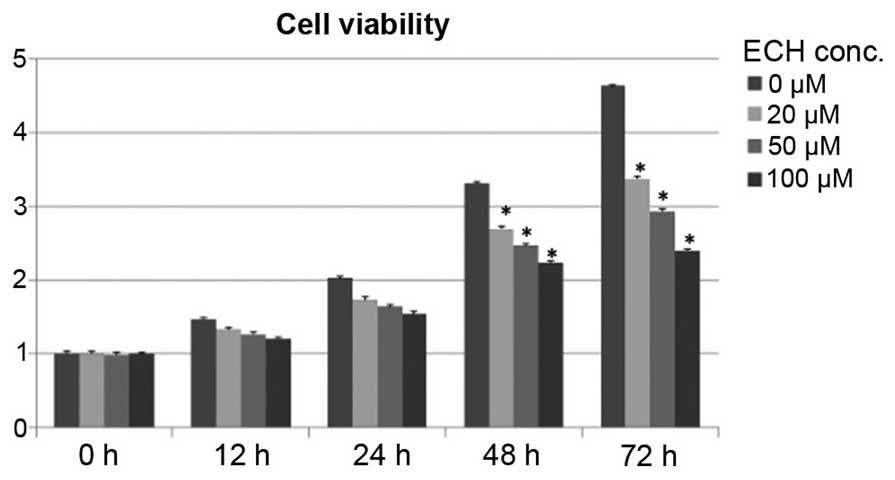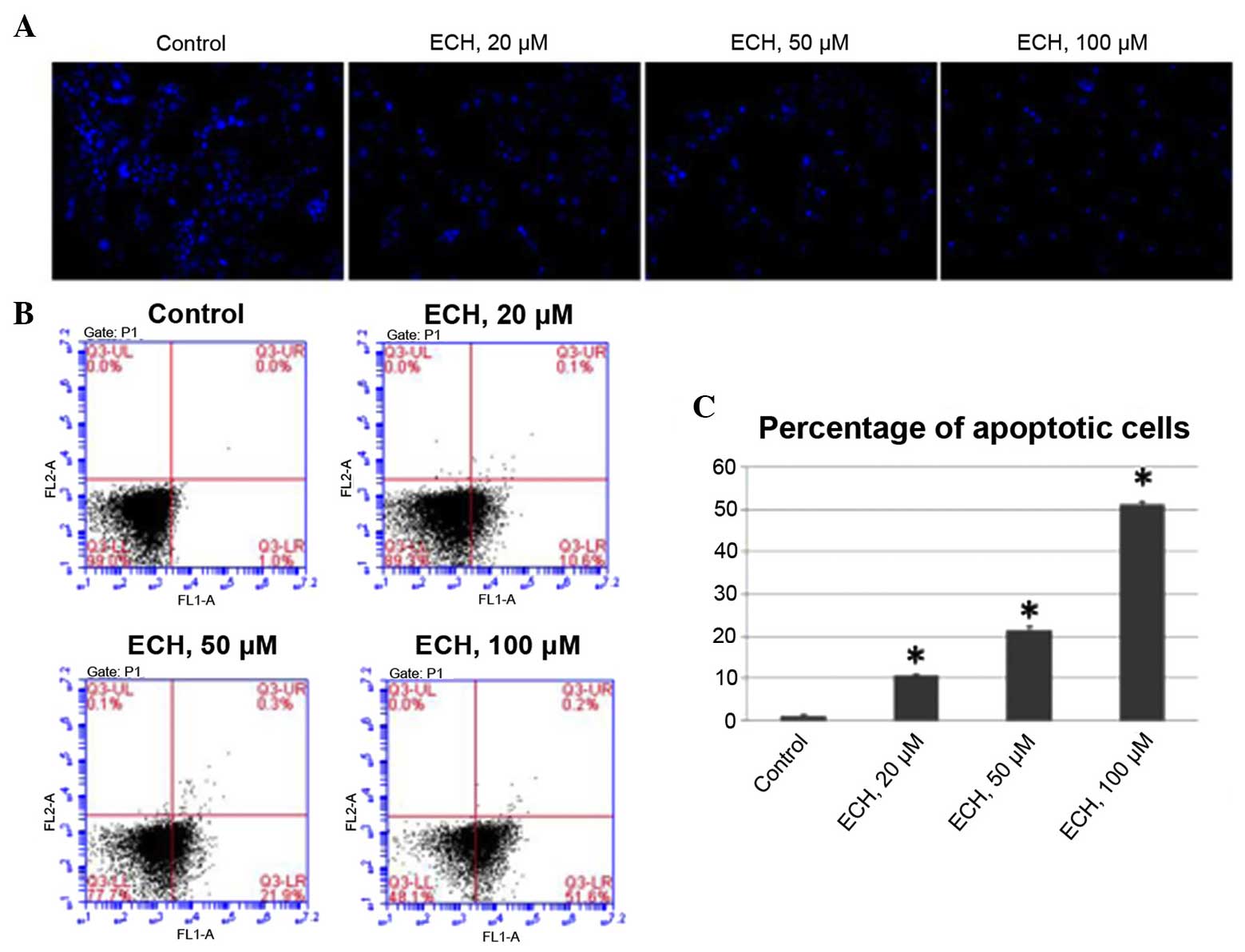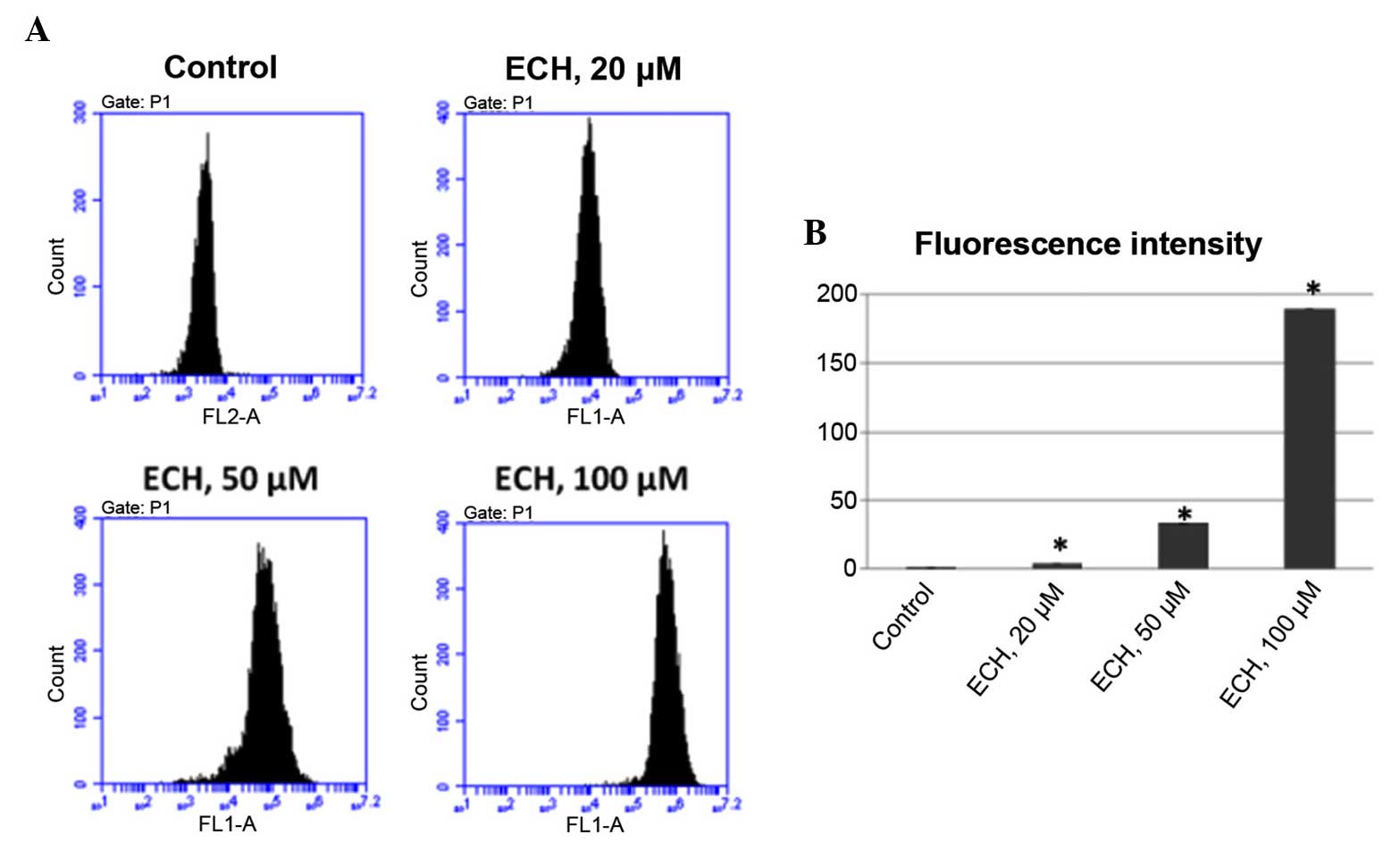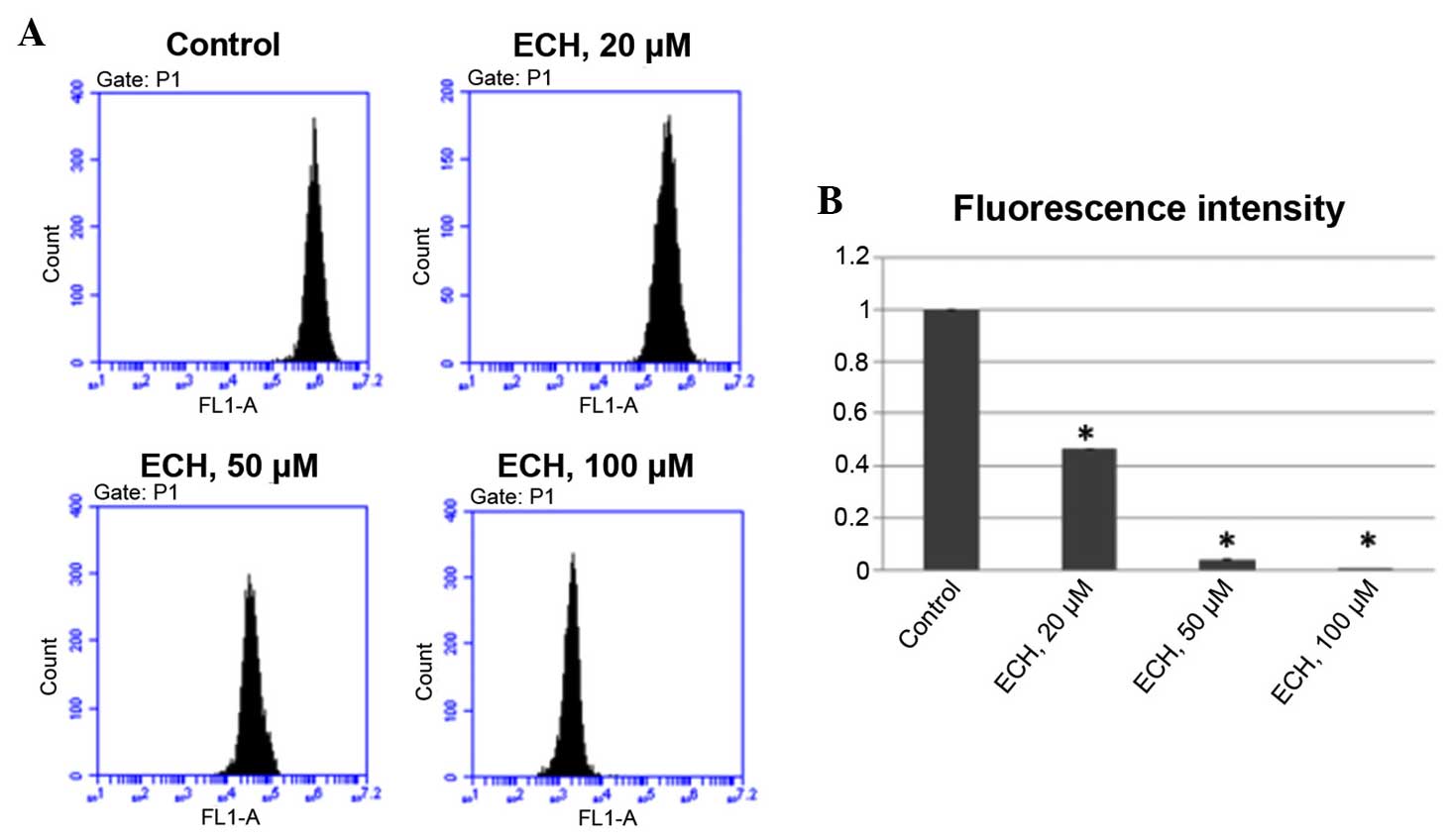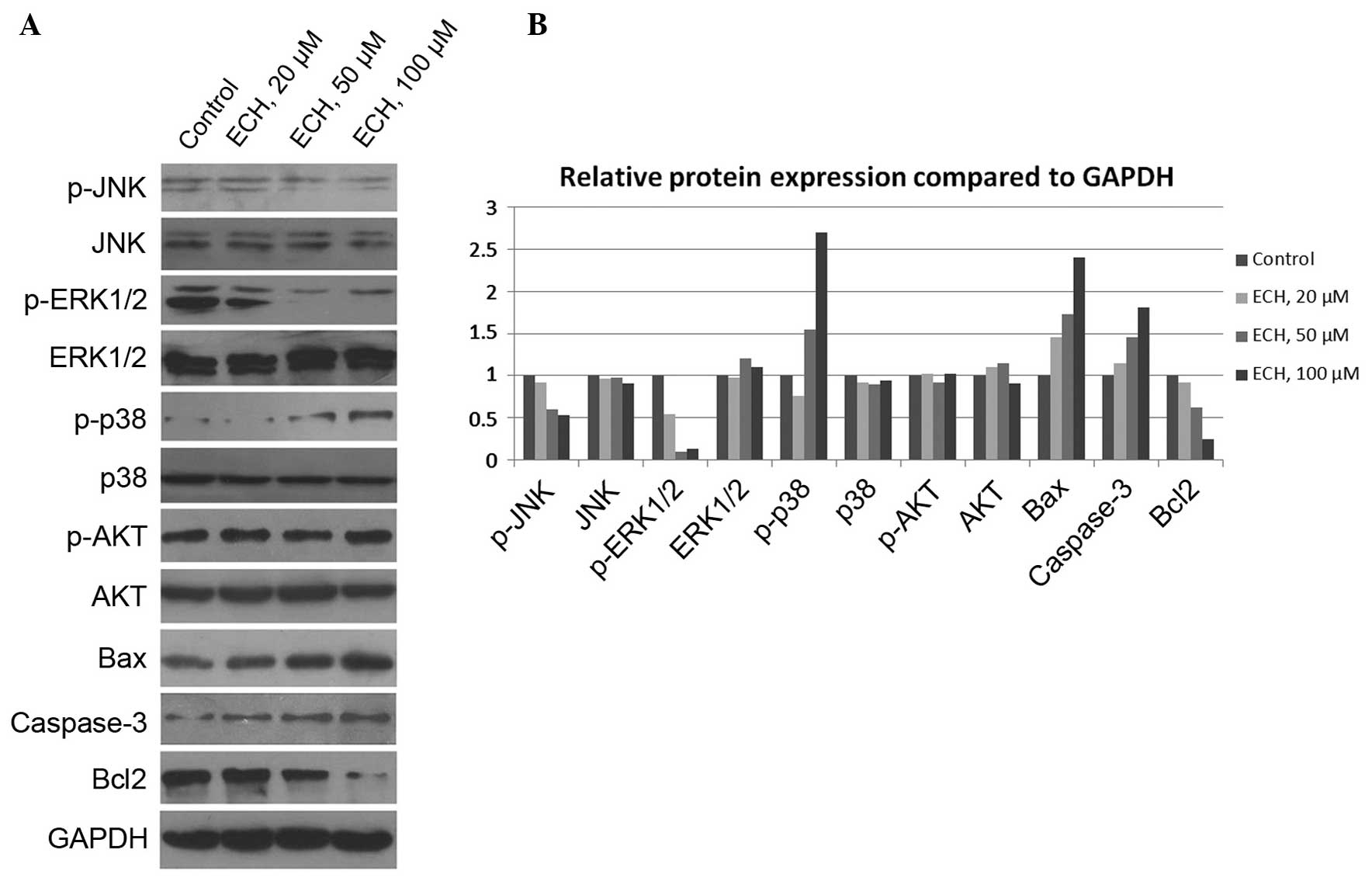Echinacoside suppresses pancreatic adenocarcinoma cell growth by inducing apoptosis via the mitogen‑activated protein kinase pathway
- Authors:
- Published online on: February 4, 2016 https://doi.org/10.3892/mmr.2016.4867
- Pages: 2613-2618
Abstract
Introduction
Cancer is a life-threatening disease and one of the leading causes of mortality worldwide. Cancer cells are characterized by inhibited apoptosis, uncontrolled growth and proliferation, and metastasis (1). The development of cancer, often initiated by genetic alterations, is a complex process that involves interactions between oncogenic proteins and tumor suppressors forming an intricate signaling network. For example, the oncogene Myc has been found to be amplified or overexpressed in various types of cancer and the Myc-encoded oncoprotein can promote tumorigenesis by driving cell cycle progression, stimulating cell growth and inducing angiogenesis (2). However, the Myc-triggered oncogenic signals can activate the p53 tumor suppressor pathway via the induction of the tumor suppressor, ARF that mitigates the oncogenic E3-ligase mouse double minute (MDM)2-mediated p53 degradation (3). This is an auto-regulated, self-protective mechanism that prevents cells from malignant transformation. Notably, p53 can repress Myc activity by transcriptionally activating, for example, miR-145 which targets Myc mRNA for translation silencing (4,5), thus forming a negative feedback regulatory loop.
The most straightforward and effective strategy to treat cancer is to kill the cancerous cells. The commonly used anticancer drugs, such as cisplatin (6), actinomycin D (7) and adriamycin (8) are shown to inhibit tumor growth by promoting apoptosis. Recently, growing evidence has demonstrated that a number of natural products and derivatives from plants, particularly from medicinal plants used in traditional Chinese medicine (TCM), exhibit a tumor suppressive function by inducing the apoptosis of cancer cells and have potential for clinical application in cancer therapy (9). For instance, the natural anthraquinone emodin isolated from the TCM, Radix rhizome Rhei, can suppress the growth of numerous types of cancer cells (10,11). Camptothecin, derived from the Chinese 'happy tree', Camptotheca acuminate, is a valuable natural product that inhibits the ligation of DNA following topo I-mediated strand breaks (12). In another retrospective population-based cohort study of a total of 729 patients with advanced breast cancer, it was suggested that TCM therapy can contribute to cancer treatment. Of this cohort, 115 patients were TCM users while 614 patients did not use TCM. The multivariate analysis demonstrated that, compared with non-users, the use of TCM was associated with a significantly decreased risk of all-cause mortality (13). All the aforementioned findings indicated that TCM is an important complementary and alternative medicine that can be used in the treatment of cancer.
Echinacoside (ECH) is a phenylethanoid isolated from the stems of Cistanches salsa, a Chinese herbal medicine, which is an important crude drug used as an antisenium and antifatigue agent (14). It has been found that several phenylethanoids possess free radical scavenging properties and protect against oxidative stress-induced toxic injuries (15). In addition, more biological properties of ECH have since been elucidated. For example, ECH can rescue the increased levels of inflammatory cytokines and improve lung histopathological abnormalities in mice with acute lung injury (16,17). Also, ECH has been shown to have protective effects on nerve tissue and improve behavioral disorders in murine models of Parkinson's disease (18). Notably, it has been found that ECH promotes cell proliferation and inhibits apoptosis in the mouse intestinal epithelial MODE-K cells (19). Thus far, however, less attention has been paid to the potential role of ECH in cancer prevention.
In this study, it was explored whether ECH treatment affects tumor cell growth and proliferation, and whether ECH induces apoptosis, elevates the production of reactive oxygen species (ROS) and reduces mitochondrial membrane potential (MMP), and consequently suppresses tumor cell growth. Furthermore the present study aimed to identify the molecular mechanisms responsible for ECH-mediated cell growth inhibition.
Materials and methods
Cell line, reagent and antibodies
SW1990 pancreatic adenocarcinoma cells (ATCC, Manassas, VA, USA) were cultured in Dulbecco's modified Eagle's medium supplemented with 10% fetal bovine serum, 50 U/ml penicillin and 0.1 mg/ml streptomycin at 37°C in a 5% CO2 humidified atmosphere. ECH was purchased from Jrdun Biotechnology Corp. (Shanghai, China). Antibodies against AKT, P-AKT, ERK, P-ERK, JNK, p-JNK, P38, p-P38 and GAPDH were purchased from Cell Signaling Technology (Danvers, MA, USA); anti-Bax and anti-Bcl-2 were purchased from Santa Cruz Biotechnology Inc. (Santa Cruz, CA, USA); and anti-Caspase-3 was purchased from Abcam (Shanghai, China).
Cell viability assay
To assess the rate of tumor cell growth, Cell Counting kit-8 (CCK-8; Dojindo Molecular Technologies, Rockville, MD, USA) was used according to the manufacturer's instructions. Cell suspensions were seeded at 5,000 cells per well with ECH treatment for 0, 12, 24, 48 or 72 h in 96-well culture plates. Cell growth inhibition was determined by adding WST-8 reagent from the CCK-8 kit at a final concentration of 10% to each well, and the absorbance of the samples was measured at 450 nm using a microplate reader (Multiskan MK3; Thermo Fisher Scientific, Inc., Waltham, MA, USA).
Hoechst 33342 staining
Cells (60% confluence) were treated with Hoechst 33342 (Beyotime Institute of Biotechnology, Haimen, China) at a final concentration of 1 µg/ml, incubated in 37°C incubator for 15 min, washed with phosphate-buffered saline twice, fixed in 4% paraformaldehyde for 30 min at room temperature, and mounted onto slides. The morphological changes of the cell nuclei were observed under a fluorescence microscope (Olympus BX51, Melville, NY, USA). The normal nuclei were round and stained light blue, while the apoptotic nuclei were shrunken and stained bright blue.
Fluorescence-activated cell sorting (FACS) analyses
For the assessment of apoptosis, the fluorescein isothiocyanate (FITC)-Annexin V Apoptosis Detection kit (BD Biosciences, Shanghai, China) was used according to the manufacturer's instructions. Briefly, 5×104 cells were washed with ice-cold PBS, resuspended in 0.1 ml binding buffer (Beyotime Institute of Biotechnology), and stained with 10 ml of FITC-conjugated Annexin V (10 mg/ml) and 10 ml propidium iodide (PI) (50 mg/ml). Following incubation for 15 min at room temperature in the dark and addition of 400 ml binding buffer, the cells were analyzed by a flow cytometer (C6; BD Biosciences, Shanghai, China).
Measurement of reactive oxygen species (ROS)
To evaluate the production of ROS, the Reactive Oxygen Species Assay kit (Vigorous Biotechnology, Beijing, China) was used according to the manufacturer's instructions. Briefly, cells (80% confluence) were harvested and washed with PBS prior to staining with the dihydroethidium (DHE) solution (Beyotime Institute of Biotechnology). Cells were then analyzed by flow cytometric analyses.
Measurement of mitochondrial membrane potential (MMP)
A tetramethylrhodamine methyl ester (TMRM) Assay kit (ImmunoChemistry Technologies, Bloomington, MN, USA) was used to detect the changes in MMP. Briefly, cells (80% confluence) were harvested, washed with PBS and stained with TMRM for 15–20 min in a 37°C incubator. Cells were then washed once with PBS and subjected to flow cytometric analyses.
Immunoblotting analyses
The cells (80% confluence) were harvested and lysed in RIPA buffer (Jrdun Biotechnology) consisting of 50 mM Tris-HCl, pH 7.4; 150 mM NaCl, 1 mM EDTA, 1% NP-40, 1% sodium deoxycholic acid and 0.1% SDS and freshly added proteasome inhibitors. Equal quantities of clear cell lysate were used for immunoblotting analysis as described previously (20).
Statistical analysis
Quantitative data are expressed as the mean ± standard deviation. Statistical differences were evaluated by unpaired Student's t-test using statistical SPSS 15.0 software. P<0.05 was considered to indicate a statistically significant difference.
Results
ECH suppresses tumor cell growth
Although it has been reported that ECH exhibits a protective role by inhibiting apoptosis and inflammatory signals in somatic cells, such as neuronal and intestinal epithelial cells (16–19), it remains elusive whether ECH controls cancerous cell growth and proliferation. To test this, a cell survival assay was conducted by treating SW1990 cells, derived from a grade II pancreatic adenocarcinoma, with titrated doses of ECH as shown in Fig. 1. Notably, it was demonstrated that ECH significantly retards tumor cell proliferation in a dose-dependent manner during a 5-day culture period (Fig. 1).
ECH triggers apoptosis
As loss of apoptosis is one of the major causative mechanisms underlying the uncontrolled proliferation of pancreatic cancer cells (21), the present study performed a set of experiments to determine whether ECH triggers apoptosis. Firstly, by staining the nuclei of tumor cells with Hoechst 33342, it was demonstrated that ECH results in apoptosis in a dose-dependent manner (Fig. 2A). Additionally, FACS analyses was conducted using Annexin V/PI staining to further confirm the apoptotic effect of ty ECH (Fig. 2B). The average percentage of apoptotic cells was 1.1% under normal culture conditions, while this percentage significantly increased to 10.6, 21.4 and 51.3% in response to ECH treatment in a dose-dependent manner (Fig. 2C). These results, together with the cell viability assay shown in Fig. 1, demonstrate that ECH treatment suppresses the proliferation of tumor cells by triggering apoptosis.
ECH prompts the production of reactive oxygen species (ROS)
Several cancer chemotherapeutic drugs, such as doxorubicin and cisplatin, have been shown to be potent generators of ROS which are crucial role in apoptosis induction under physiological and pathological conditions (22). Thus, it was investigated whether ECH treatment could also regulate ROS production. To test this, DHE, which can be oxidized to generate ethidium that intercalates with DNA, was used in this study to evaluate ROS production. It was found that, like other anticancer drugs, ECH also stimulates ROS production in a dose-dependent manner as shown by the elevated fluorescence intensity upon ECH treatment (Fig. 3).
ECH reduces MMP
Mitochondrial dysfunction has been shown to be implicated in the induction of apoptosis. Opening of the mitochondrial permeability transition pore has been demonstrated to induce the depolarization of the transmembrane potential and the release of pro-apoptotic factors (23). Therefore, it was tested whether ECH could induce loss of MMP in tumor cells by performing a TMRM assay, which is a well-established approach, as the intensity of TMRM fluorescence is proportional to the membrane potential. It was demonstrated that ECH treatment significantly reduces MMP in a dose-dependent manner (Fig. 4).
ECH controls tumor cell growth via mitogen-activated protein kinase (MAPK), but not AKT, signals
To further investigate the molecular basis of ECH-mediated tumor cell death, the activity of several vital signaling pathways, such as MAPK and AKT (24,25), which control cell survival and death was examined. The MAPKs are evolutionarily conserved, proline-directed Ser/Thr protein kinases, including extracellular signal-regulated kinases (ERKs), c-Jun NH2-terminal kinase (JNKs) and the p38 family members which are activated through three-tier kinase signaling cascades (26,27). In this study, the expression of MAPKs and AKT, as well as their activated phosphorylated forms, was assessed and it was revealed that ECH markedly suppresses JNK and ERK1/2 activity, but enhances p38 activity (Fig. 5). Notably, it was demonstrated that AKT activity, which is also critically important for cell proliferation, is not affected by ECH treatment (Fig. 5). In addition, it was shown that ECH treatment elevates the expression of Bax and Caspase-3 whilst reduces Bcl-2 expression (Fig. 5), which is consistent with Fig. 2. Thus, the results indicate that ECH triggers tumor cell apoptosis via the MAPK pathway.
Discussion
To the best of our knowledge, this is the first study to show that ECH has a tumor suppressive function by triggering apoptosis (Fig. 2), promoting ROS production (Fig. 3) and inducing mitochondrial membrane potential depolarization (Fig. 4), consequently leading to tumor cell growth inhibition (Fig. 1). Furthermore, the molecular basis of ECH-mediated tumor cell death was shown to occur by regulating MAPK signaling pathways (Fig. 5). These findings demonstrate a novel function of ECH in preventing tumorigenesis and thus suggest that it may be a candidate agent for cancer therapy.
The majority of anticancer drugs can induce tumor cell apoptosis, senescence and/or cell cycle arrest, which leads to inhibition of tumor cell growth and proliferation. Cell cycle arrest is a cellular response to mild stress signals that allow cells to repair damaged DNA prior to initiating replicative DNA synthesis or mitosis, whereas apoptosis and senescence (permanent cell cycle arrest) occur in response to stress signals that eliminate irreparable or malignant cells (28,29). Therefore, only the apoptotic effect of ECH on tumor cells was assessed in this study, as killing cancerous cells is a major criterion for evaluating the potency of an anticancer agent. Notably, it was demonstrated that ECH induces the expression of Bax (Fig. 5), a pro-apoptotic gene, transcriptionally activated by the tumor suppressor p53 (30). Thus, it is worthwhile to test whether ECH can activate the p53 signaling pathway. If so, ECH may also be able to elicit p53-dependent cell cycle arrest, senescence, apoptosis or autophagy. In this study, the tumor suppressive function of ECH in the SW1990 pancreatic adenocarcinoma cell line was elucidated. However, further studies observing more pancreatic cancer cell lines, are required. It has been shown that mutations in the oncogenic protein RAS and the tumor suppressor p53 are associated with the development of pancreatic cancer (31); however, the SW1990 cell line does not harbor any p53 mutation, according to the IARC p53 database (http://p53.iarc.fr/CellLines.aspx). Hence, it is important to investigate whether ECH can affect the growth and proliferation of other pancreatic cancer cell lines with different p53 mutations. Additionally, it would be interesting to determine whether ECH is able to promote apoptosis and inhibit the growth of other types of tumors.
ROS elevation and MMP reduction, which were caused by ECH treatment, have been shown to be essential in apoptosis induction (22). In addition, it has been found that ROS can induce the oxidation of the mitochondrial pores contributing to the release of cytochrome c, an intermediate in apoptosis, due to disruption of the MMP (22). Thus, it remains to be determined whether ECH disrupts MMP indirectly through induction of ROS. Moreover, ROS-elicited oxidative stress has also been shown to be involved in modulating a myriad of cell-growth controlling signals, including p53, NF-κB, HIFs and PI3K (32). It remains to be determined whether and, if so, how ECH regulates these important signaling pathways. Notably, oxidative stress causes various neurodegenerative diseases due to the high oxygen consumption, weak antioxidative systems and terminal-differentiation characteristics of the central nervous system (33). However, several studies have shown that ECH has protective and anti-apoptotic effects on nervous tissue. In this regard, it is reasonable to hypothesize that ECH may reduce ROS production in the terminal-differentiated neural cells. Therefore, it also remains to be determined whether the regulation of ROS production by ECH is dependent on the cell differentiation status. Hence, the present results together with other studies reveal that ECH, the widely used TCM, can be an important chemotherapeutic strategy not only for the treatment of neurodegenerative diseases but also malignant carcinomas.
Recently, using TCM in cancer therapy has gained increasingly more attention. The potential of natural products from medicinal plants used in TCM has been recognized by the scientific community even in the western world (9). Efforts are required to elucidate the underlying mechanisms of action of these natural products, which may eventually lead to the development of efficient and safe medicines for cancer therapy.
In conclusion, the present study demonstrated the tumor inhibitory function of ECH and also elaborates the molecular basis of ECH-mediated tumor suppression, thus suggesting the potential clinical application of ECH in cancer therapy.
Acknowledgments
This study was funded and supported by the Key Program of Scientific Research of FMU(grant no. 09ZD014). The authors would like to thank Biomedworld (Shanghai, China) for help with editing the manuscript.
References
|
Hanahan D and Weinberg RA: Hallmarks of cancer: The next generation. Cell. 144:646–674. 2011. View Article : Google Scholar : PubMed/NCBI | |
|
Alderton GK: Transcription: The transcriptional effects of MYC. Nat Rev Cancer. 14:5132014. View Article : Google Scholar : PubMed/NCBI | |
|
Zindy F, Eischen CM, Randle DH, Kamijo T, Cleveland JL, Sherr CJ and Roussel MF: Myc signaling via the ARF tumor suppressor regulates p53-dependent apoptosis and immortalization. Genes Dev. 12:2424–2433. 1998. View Article : Google Scholar : PubMed/NCBI | |
|
Sachdeva M, Zhu S, Wu F, Wu H, Walia V, Kumar S, Elble R, Watabe K and Mo YY: p53 represses c-Myc through induction of the tumor suppressor miR-145. Proc Natl Acad Sci USA. 106:3207–3212. 2009. View Article : Google Scholar : PubMed/NCBI | |
|
Liao JM, Cao B, Zhou X and Lu H: New insights into p53 functions through its target microRNAs. J Mol Cell Biol. 6:206–213. 2014. View Article : Google Scholar : PubMed/NCBI | |
|
Zamble DB and Lippard SJ: Cisplatin and DNA repair in cancer chemotherapy. Trends Biochem Sci. 20:435–439. 1995. View Article : Google Scholar : PubMed/NCBI | |
|
Kleeff J, Kornmann M, Sawhney H and Korc M: Actinomycin D induces apoptosis and inhibits growth of pancreatic cancer cells. Int J Cancer. 86:399–407. 2000. View Article : Google Scholar : PubMed/NCBI | |
|
Tacar O, Sriamornsak P and Dass CR: Doxorubicin: An update on anticancer molecular action, toxicity and novel drug delivery systems. J Pharm Pharmacol. 65:157–170. 2013. View Article : Google Scholar : PubMed/NCBI | |
|
Efferth T, Li PC, Konkimalla VS and Kaina B: From traditional Chinese medicine to rational cancer therapy. Trends Mol Med. 13:353–361. 2007. View Article : Google Scholar : PubMed/NCBI | |
|
Yim H, Lee YH, Lee CH and Lee SK: Emodin, an anthraquinone derivative isolated from the rhizomes of Rheum palmatum, selectively inhibits the activity of casein kinase II as a competitive inhibitor. Planta Med. 65:9–13. 1999. View Article : Google Scholar : PubMed/NCBI | |
|
Zhang L, Chang CJ, Bacus SS and Hung MC: Suppressed transformation and induced differentiation of HER-2/neu-overexpressing breast cancer cells by emodin. Cancer Res. 55:3890–3896. 1995.PubMed/NCBI | |
|
Pommier Y: Topoisomerase I inhibitors: Camptothecins and beyond. Nat Rev Cancer. 6:789–802. 2006. View Article : Google Scholar : PubMed/NCBI | |
|
Lee YW, Chen TL, Shih YR, Tsai CL, Chang CC, Liang HH, Tseng SH, Chien SC and Wang CC: Adjunctive traditional Chinese medicine therapy improves survival in patients with advanced breast cancer: A population-based study. Cancer. 120:1338–1344. 2014. View Article : Google Scholar : PubMed/NCBI | |
|
Xiong Q, Hase K, Tezuka Y, Namba T and Kadota S: Acteoside inhibits apoptosis in D-galactosamine and lipopolysaccharide-induced liver injury. Life Sci. 65:421–430. 1999. View Article : Google Scholar : PubMed/NCBI | |
|
Gao JJ, Igalashi K and Nukina M: Radical scavenging activity of phenylpropanoid glycosides in Caryopteris incana. Biosci Biotechnol Biochem. 63:983–988. 1999. View Article : Google Scholar : PubMed/NCBI | |
|
Zhang Y, Xing J, Ai T, Wen T, Guan L and Zhao J: Protection of echinacoside against acute lung injury caused by oleic acid in rats. Free Radic Res. 41:798–805. 2007. View Article : Google Scholar : PubMed/NCBI | |
|
Li X, Gou C, Yang H, Qiu J, Gu T and Wen T: Echinacoside ameliorates D-galactosamine plus lipopolysaccharide-induced acute liver injury in mice via inhibition of apoptosis and inflammation. Scand J Gastroenterol. 49:993–1000. 2014. View Article : Google Scholar : PubMed/NCBI | |
|
Zhao Q, Gao J, Li W and Cai D: Neurotrophic and neurorescue effects of Echinacoside in the subacute MPTP mouse model of Parkinson's disease. Brain Res. 1346:224–236. 2010. View Article : Google Scholar : PubMed/NCBI | |
|
Jia Y, Guan Q, Guo Y and Du C: Echinacoside stimulates cell proliferation and prevents cell apoptosis in intestinal epithelial MODE-K cells by up-regulation of transforming growth factor-β1 expression. J Pharmacol Sci. 118:99–108. 2012. View Article : Google Scholar | |
|
Liao P, Wang W, Shen M, Pan W, Zhang K, Wang R, Chen T, Chen Y, Chen H and Wang P: A positive feedback loop between EBP2 and c-Myc regulates rDNA transcription, cell proliferation and tumorigenesis. Cell Death Dis. 5:e10322014. View Article : Google Scholar | |
|
Westphal S and Kalthoff H: Apoptosis: Targets in pancreatic cancer. Mol Cancer. 2:62003. View Article : Google Scholar : PubMed/NCBI | |
|
Simon HU, Haj-Yehia A and Levi-Schaffer F: Role of reactive oxygen species (ROS) in apoptosis induction. Apoptosis. 5:415–418. 2000. View Article : Google Scholar | |
|
Ly JD, Grubb DR and Lawen A: The mitochondrial membrane potential (deltapsi(m)) in apoptosis; an update. Apoptosis. 8:115–128. 2003. View Article : Google Scholar : PubMed/NCBI | |
|
Munshi A and Ramesh R: Mitogen-activated protein kinases and their role in radiation response. Genes Cancer. 4:401–408. 2013. View Article : Google Scholar : PubMed/NCBI | |
|
Abraham AG and O'Neill E: PI3K/Akt-mediated regulation of p53 in cancer. Biochem Soc Trans. 42:798–803. 2014. View Article : Google Scholar : PubMed/NCBI | |
|
Tournier C: The 2 Faces of JNK Signaling in Cancer. Genes Cancer. 4:397–400. 2013. View Article : Google Scholar : PubMed/NCBI | |
|
Koul HK, Pal M and Koul S: Role of p38 MAP kinase signal transduction in solid tumors. Genes Cancer. 4:342–359. 2013. View Article : Google Scholar : PubMed/NCBI | |
|
Brady CA and Attardi LD: p53 at a glance. J Cell Sci. 123:2527–2532. 2010. View Article : Google Scholar : PubMed/NCBI | |
|
Carvajal LA and Manfredi JJ: Another fork in the road-life or death decisions by the tumour suppressor p53. EMBO Rep. 14:414–421. 2013. View Article : Google Scholar : PubMed/NCBI | |
|
Miyashita T and Reed JC: Tumor suppressor p53 is a direct transcriptional activator of the human bax gene. Cell. 80:293–299. 1995. View Article : Google Scholar : PubMed/NCBI | |
|
Morton JP, Timpson P, Karim SA, Ridgway RA, Athineos D, Doyle B, Jamieson NB, Oien KA, Lowy AM, Brunton VG, et al: Mutant p53 drives metastasis and overcomes growth arrest/senescence in pancreatic cancer. Proc Natl Acad Sci USA. 107:246–251. 2010. View Article : Google Scholar : | |
|
Schieber M and Chandel NS: ROS function in redox signaling and oxidative stress. Curr Biol. 24:R453–R462. 2014. View Article : Google Scholar : PubMed/NCBI | |
|
Li J, O W, Li W, Jiang ZG and Ghanbari HA: Oxidative stress and neurodegenerative disorders. Int J Mol Sci. 14:24438–24475. 2013. View Article : Google Scholar : PubMed/NCBI |



